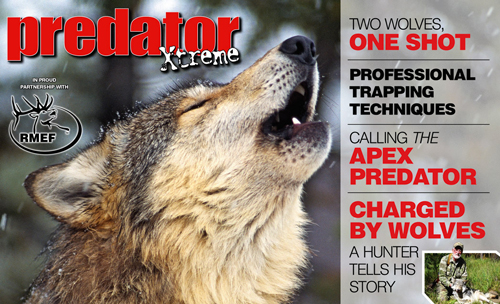Featured in the Predator Xtreme WOLF Issue, a FREE Digital Magazine
Idaho had its first wolf-hunting season in 2009, and I knew then that I wanted to become a wolf hunter.
I was familiar with some of the wolf’s habits: Wolves are a predator at the top of the food chain, subsisting mostly on ungulates — elk, deer, moose, bison, caribou, domestic cattle and sheep. Their diet also includes smaller animals, such as ground squirrels, rabbits, beavers and even salmon. I had a feeling that hunting this animal would not be an easy task. I studied every piece of credible information available on wolf hunting, both old and new. I also sought out the most knowledgeable trappers and hunters I could find who had experience with wolves. I even became a licensed trapper in the state of Idaho.
A Hunter’s Tips
Trial and error from my first hunting experiences with wolves in 2009 taught me a lot. The following are some strong considerations when wolf hunting.
Preseason scouting is invaluable. Do as much as you can. Also, practice howling with your voice until you can mimic the howl of a wolf, but be careful while calling in wolf country. If wolves don’t answer your howl, it doesn’t mean they are not there or don’t hear you. They are both curious and cautious. I’ve seen them sniff the air while I’m howling. If they get your scent, they disappear like ghosts. Pay constant attention to wind direction. Tracks and scat are other indicators of wolf activity in your hunting area. However, wolves are capable of traveling long distances in a very short period of time. Some packs travel in a specific circuit, coming back to the same area maybe five to seven days later. Some stay in an area for a period of time, then move on. It’s all dependent on the prey base. Remember that wolves need to eat a lot to maintain their energy levels for hunting, staying warm and reproducing. An adult wolf can eat 20 to 22 pounds of meat after making a kill. The wolf pups are moved around to different rendezvous sites and brought food by the adults in the pack. This goes on until the pups are old enough to run with the pack. If you can find a rendezvous site with pups, you know the adults will be back.
Maintain a large geographic coverage area, giving yourself the best advantage of finding fresh scat and tracks on a regular basis. Don’t limit yourself to one area just because you have seen tracks or scat. Set up multiple trail cameras and check them on a regular basis for any wolf activity. Move them around to different areas. Try howling along your route, and give wolves time to answer before moving on. If wolves do answer, try to ascertain if they are moving toward you, moving away from you or staying put. If they are staying put or moving toward you, get on the offensive and move toward them, staying concealed and watching the wind.
During the 2011 season I took an aggressive approach to avoid the mistakes I made in 2009. I took every piece of information, knowledge and experience and put it to work. On day two of the 2011 wolf season, I harvested two wolves within one minute of each other. Without the preseason scouting that I put in, I’m not sure I would have been successful. These two wolves were members of a pack of eight to 10 animals that I called in by howling and keeping myself concealed.
A Brush With Wolves
Sept. 9 of the 2014 season proved to be a day I will never forget. While wolf hunting Idaho’s backcountry, I had a brush with wolves. It was midday and I was enjoying a typical Indian summer that prevails during this time of year. The day thus far had been uneventful. I broke camp early that morning and had been hunting hard. I decided to venture into an area that I had previously archery elk hunted some 10 years before. The place looked much different than before. Two major fires had burned through the area in 2006 and 2007. There was a lot of blowdown timber with knee-high grass. Standing, dead and burned lodgepole pine dotted the landscape.
I decided to try to walk up the south-facing side of a beautiful creek I was familiar with. However, it wasn’t long before I was waist high in the blowdowns and grass. I decided to keep going and hope for some easier walking further ahead. I navigated the terrain, and after about 30 minutes, walking became somewhat easier. At this point, I decided to give out a howl. I hadn’t seen any sign of wolves, but I howled twice anyway. No answer. I howled again.
Some 200 to 300 yards on the opposite side of the creek and upslope, a chorus of wolf howling erupted. I waited several minutes, then howled again. Again, I got an answer from multiple wolves. I knew I had a pack just above me, and my heart began beating faster as adrenaline started coursing through my body. The howling animals appeared to have gotten closer the second time. I decided to cross the stream and work upslope toward the wolves.
The terrain and blowdowns hampered my movement tremendously, but I kept howling and the wolves kept answering me and closing the distance. The burned forest had started to grow small trees and grass in the years since the fire. However, there wasn’t a tree in sight with limbs that I could climb, just in case I needed to escape. At this point, the wolf howling became so loud that I knew they had to be on top of me.
This is when it happened. I peered around a tree and saw no fewer than 10 wolves bounding downhill straight for me as fast as they could go through the grass and around trees. In an instant they had encircled my location, and one of them brushed against my left leg as it passed by me. Most of them quickly stopped after seeing me.
The adrenaline was pumping through my veins so hard and fast. Some of the wolves started making short, quick barking sounds. Remember, all this happened in a matter of seconds. I quickly raised my rifle, shot and killed the first wolf I found in my scope. The remaining wolves bolted, weaving in and around trees and through the knee-high grasses to such an extent that I couldn’t get a solid target on another one.
After quickly evaluating the situation I was in, I sat down next to the dead wolf I’d shot, concealing myself in the grass. The remaining wolves continued to howl; I howled in response. I could see them running between trees, but I still couldn’t get a good solid target on one of them. My hope was to bring them back to me, especially since they had left one of their pack members behind.
This back-and-forth howling continued for approximately 10 minutes. After that, I could no longer see them or hear them. I took a few minutes to collect myself, calm my nerves and go over in my mind what had just happened. I then proceeded to load the wolf on my shoulders and search for an easy way back to my truck through the blowdowns. This turned out to be no easy task. After about four or five rests and an hour later, the wolf and I made it back to my truck. Upon returning to my camp, I skinned out the wolf and prepared it for transport the next day to have it checked in by Fish and Game officials.
With evening approaching, I decided to go back to the area where I had harvested the wolf. Once there, I began to howl. Immediately, the pack answered back! The wolves were looking for the lost member of their pack. They also knew that my howl was not one of their own. This is why they charged me in the first place — I was a threat to their territory and they came to investigate. Had I been a member of another pack or a lone wolf, I probably would have been killed. As darkness crept into the forest, the wolves stopped being vocal and appeared to move away from the area. It’s not likely I will ever replicate this hunting adventure again, but I’ll be back for new adventures for sure.
For more wolf hunting gear, tactics, tips, and stories check out the Predator Xtreme WOLF Issue.
Never miss an issue!







